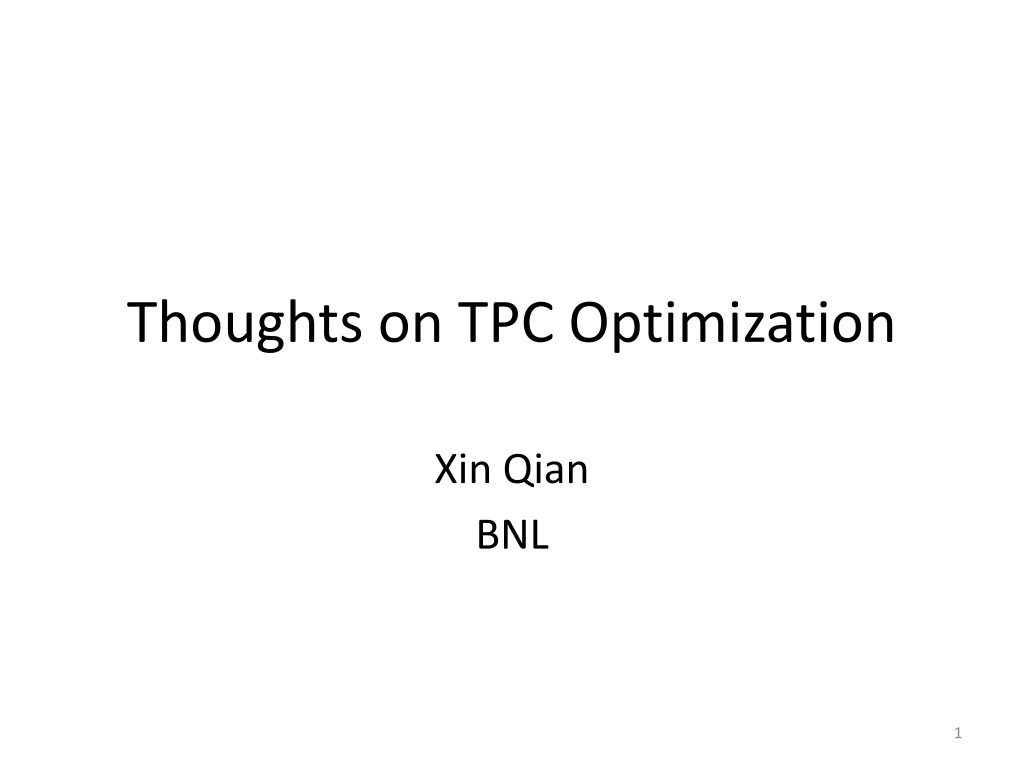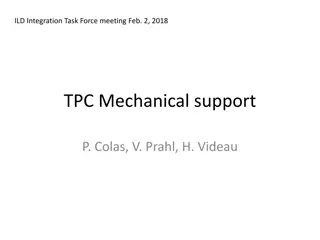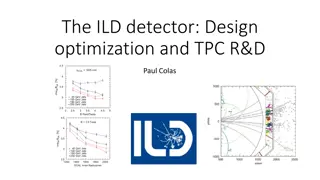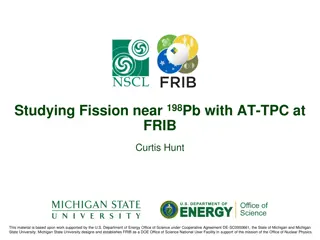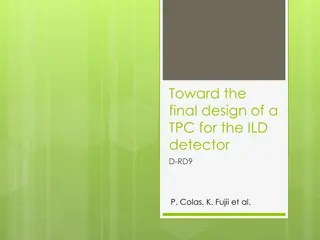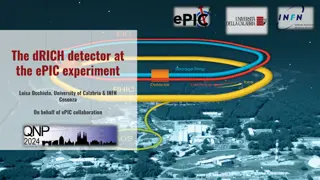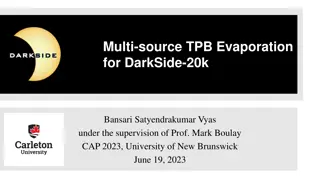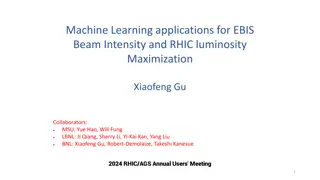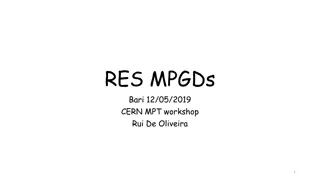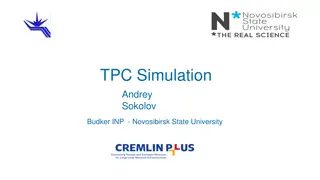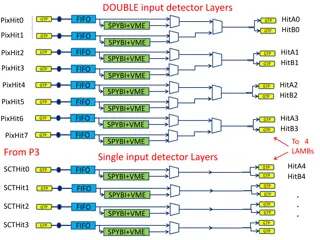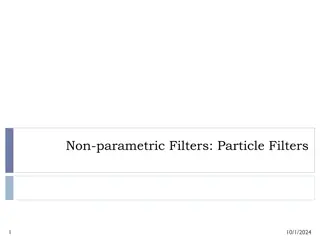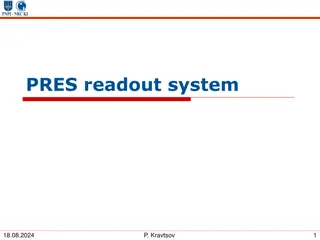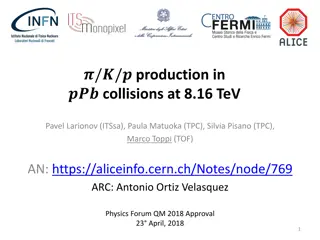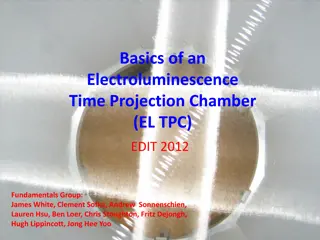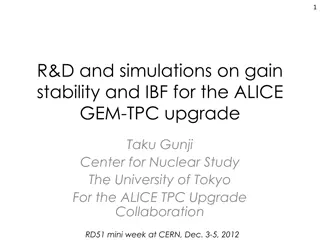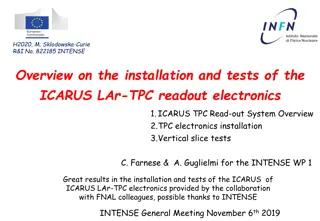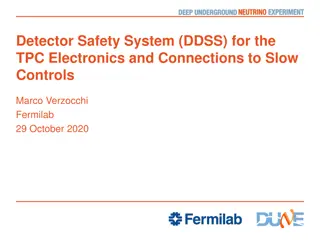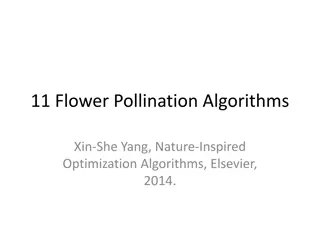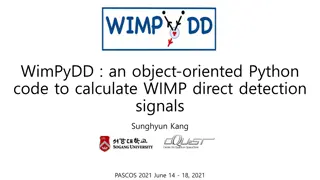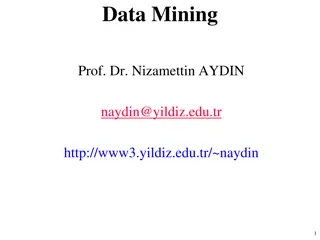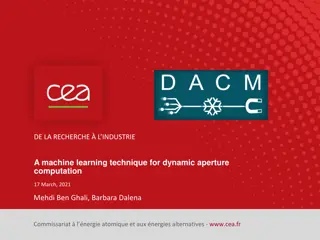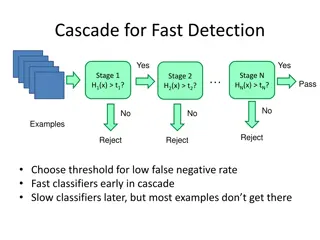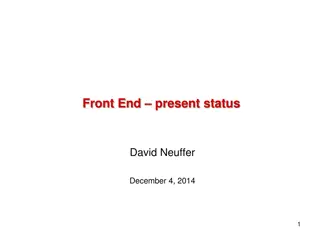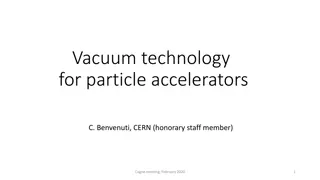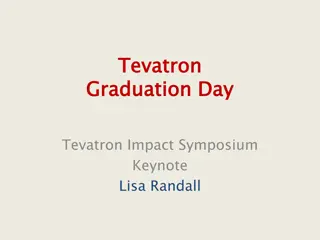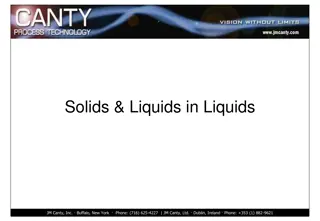Insights on TPC Optimization for Particle Detection
Explore the optimization of Time Projection Chambers (TPC) for particle detection through discussions on basic reconstruction, charge resolution, detector parameters, wire pitch, signal processing, deconvolution techniques, and noise analysis. Gain valuable insights on field and electronics responses, gain and shaping time optimization, as well as advancements in signal extraction and processing in TPC systems.
Download Presentation

Please find below an Image/Link to download the presentation.
The content on the website is provided AS IS for your information and personal use only. It may not be sold, licensed, or shared on other websites without obtaining consent from the author. Download presentation by click this link. If you encounter any issues during the download, it is possible that the publisher has removed the file from their server.
E N D
Presentation Transcript
Thoughts on TPC Optimization Xin Qian BNL 1
Outline Basic reconstruction Charge resolution Detector Parameters TPC angle Position resolution Wire pitch Image reconstruction quality Wire angle Wire pattern High level physics Particle identification Wire plane gap Resolution 2
Gain and Shaping Time Optimization for Cold Electronics 3
Overview of Signal Processing Number of ionized electrons V. Radeka Field Response Signal on Wire Plane Electronics Response Signal to be digitized by ADC (Deconvolution) High-level tracking time TPC signal consists of time and charge information from induction and collection planes Same amount charge was seen by all the wire planes 4
Deconvolution Frequency Content Time domain = ) ( ) S t dt M( ) ( t R t t 0 0 t Fourier transformation M = R( ) S( ) ( ) Deconvoluted Signals Frequency domain M( ) R( ) S( ) = ( ) F The goal of deconvolution is to help extract charge and time information from TPC signals Back to time domain Anti-Fourier transformation S(t) Time Domain 5 Bruce Baller developed during Argoneut
Field and Electronics Response Leon, SLAC Charge vs. Time averaged for a single electron Difference between simulation and data (bigger signal in LongBo arXiv:1504:00398) Cold electronics: 4 shaping time (0.5, 1.0, 2.0, 3.0 us) 4 gain (4.7, 7.8, 14, 25 mV/fC) [Digitized (ADC)] [# of e ] [Field res. (fC/e )] [Ele. res. (mV/fC)] 2.5(ADC/ mV) = 6
Discussion about Noise There are two components of noise Electronic noise (ENC) The signal to noise ratio does not depend on the gain Longer shaping time has smaller noise Longer shaping time has slightly worse two-peak separation Digitization noise due to 12-bit ADC At 3 ms and 4.7 mV/fC, the electronic noise at collection plane is expected to be 0.58 ADC 1/sqrt(12.) ~ 0.29 ADC 11.7 ENOB 1.23/sqrt(12.) ~ 0.36 12-bit ADC is enough so that digitization noise << electronic noise 7
Discussion about Gain and Shaping Time The choice of gain will not affect the signal to noise ratio Higher gain could lead to more chances of overflow Also need to take into account the zero-suppression algorithm Longer shaping time would Increase the size of signal higher chance to overflow Reduce noise, thus increase signal/noise ratio Slightly worse two-peak separation (difference between 2.5 and 3 us) Also less digitization time (Nyquist: Tshaping >= 2 Tdigitization) Less data 8
Optimization of Field Response Functions 9
Gap between Wire Plane, Bias Voltage, and Grid Plane The raw signal (digits) consists of both signal and (electronic) noise An ideal deconvolution will recover signal completely number of electrons reached The deconvolution on the electronic noise will thus determine the signal to noise ratio Noise N R ( ) = ( ) F ( ) Change in the gap distance and bias voltage will change response function R signal to noise ratio To be worked out 10
MicroBooNE Case In MicroBooNE, the second induction plane has the worst signal to noise ratio Jyoti Joshi 11
Some Questions Preliminary results for 1D deconvolution What s the impact of dynamic induced charge? Data validation 12
TPC Angle(I) LArTPC Liquid Scintillator High density (Z ~ 18) Event are more compact Parallel wire readout w.r.t. the beam direction More ambiguities Slow detector response (~ms) Challenges in rejecting cosmics for detector on surface Ultra-high resolution A layer ~ 3.5% X0 (14 cm R.L.) Low density (Z ~ 6) Perpendicular wire readout w.r.t. the beam direction Fast detector response (~10 ns) High resolution A layer ~ 0.15 X0 (44 cm) Higher physics requirement ~ 80% efficiency ~35% efficiency in NO A 13
TPC Angle (II) In a neutrino event, because of incident neutrino energy, the entire event is more boosted toward forward region Due to nucleon response, the lepton tends to going more forward in the center-of-mass frame TPC with wire readout has more trouble to reconstruct tracks which are parallel to the wire plane charges arrive at various wire-plane at same time ambiguity to figure out the proper correlation http://www.phy.bnl.gov/wire-cell/ bee/set/4/event/2/ 14
Detector Angle http://www.phy.bnl.gov/wire- cell/bee/set/7515fe16-d163-4df8-ad87- 09f7c809dc7e/event/0/ Same events (rotate 0-19 degrees) Event 0 0 degrees Event 10 10 degrees Event 19 19 degrees 15
One can click the web-site to look at events in 3D and rotate to get a better understanding. 10 degrees 10 degrees (truth) 0 degrees 16
10 degrees 19 degrees http://www.phy.bnl.gov/wire-cell/bee/set/6/event/8/ MC truth: one electron, one neutral pion, and one positve pion 17
First Look at the TPC Orientation Generated by GENIE Look at the electron angle for two configurations: default vs. 10 degrees rotation Integrated over all the energy, oscillation added ~ 20 % effect at the 0 degrees with rotating 10o Effect is expected to be strongly energy-dependent Right plot shows the expected distribution at Argoneut (5-6 GeV) energy 18
Questions How to evaluate which angle is good enoug? Is perpendicular wire-readout completely hopeless? Can we add in intended distortion in electric field? How to calibrate its effect? 19
Wire Pitchs impact on Charge For a electron drift at different locations within a wire pitch Field response has a strong dependence on the location of electron Deconvolution was performed with average field response Large wire pitch smaller (electronic) noise to signal ratio smaller resolution Large wire pitch larger spread at response function larger resolution 20
Questions What s the expected charge resolution and its dependence on the wire pitch? How important is dynamic induced charge effect? How to calibrate the 2D response function? 21
About Wrapping (Wire Angle) Wire angle would impact the wire wrapping scheme What s the problem of wire wrapping? The wrapping of wire would lead to more crossings of wires the wires originally won t cross can cross with wrapping the crossing of wires will introduce ambiguities The amount of ambiguities strongly depends on the event activity v3 u2 True Hits v2 For a simple track, it is not a problem For multiple tracks, more difficult For showers, much more difficult For shower + track + crossing APA extremely difficult u1 H1 v1 H2 At fixed time H4 Fake Hits H3 H5 H6 Wire-cell imaging step is an ideal tool to study this (use both charge and time to do reconstruction) 22
Wire Pitch/Angle on Position Resolution Along the drift direction, the digitization length is 0.5 us * 1.6 mm/us 0.8 mm @ 500 V/cm Average diffusion =0.9 mm for 2.5 m drift distance Signal shaping time 2 us 2 us / 2.45 * 1.6 ~ =1.3 mm For wire plane, the digitization length is related to the wire pitch (3 ~ 5 mm) For a continuous track, not a problem to calculate dE/dx For the end points of track, the resolution in dx is about 0.3 * L Perpendicular to vertical wire: L = wire pitch Parallel to vertical wire: L ~ (wire pitch)/sin(theta) Consequences in short tracks (PID, angle, energy through range ) Gap identification (i.e. for e/gamma separation) Likely need 2 * L to identify a gap 23
More about Gap Identification Radiation length ~ 14 cm for high-energy photon, the mean free path 9/7 * 14 ~ 18 cm Assumption Along the drift direction: 4 us for two-peak separation Perpendicular to drift direction 2 * L Observations: 3 mm identification efficiency is reduced by about 2.x% ~ (1- exp(-4/180)) ~60% more background 5 mm, gap 36 of gap identification efficiency is one order smaller 45 degrees, the impact Also varied pitch for different planes (Maxim) 24
Discussions For bigger wire pitch, the gap identification efficiency will be reduced without a doubt 3 mm 5 mm wire pitch leads to about 2.2 % reduction in efficiency But this number corresponds to ~60% more background There are three weapons to differentiate electron from gamma: Gap identification dE/dx (initial track is about 3 cm long, what s the impact of wire pitch?) Shower topology (i.e. gamma is always from neutral pion decay, thus multiple gammas) The real question is which wire pitch is good enough to reject background? Also engineering considerations Will small wire pitch leads to more chance of wire touching and high noise? 25
These two would explain the shape of dE/dx plot Compton Scattering I calculated 5 cm mean free path based on moller scattering cross section, cross checked with MC 26
e/gamma separation dE/dx Compton ~ Z Pair production ~ Z^2 Compton scattering could lead to confusion of dE/dx 27
Summary From reconstruction point of view, the priority (from high to low) is TPC angle (5-10 degrees from the beam direction) Within this range, larger angle is better When will be enough (i.e. increment is modest)? Wire Pitch (gap identification, dE/dx) 3 mm is better Will 5 mm be enough? Wire Angle (reduce ambiguity, position resolution) To be studied Wire gap and bias voltage (charge resolution) To be studied 28
